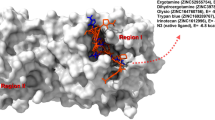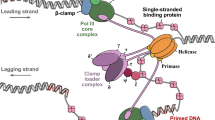Abstract
In this report we present our preliminary results on the explanation of possible roles that mutations at positions 41, 67, 70, 215, and 219 of the p66 subunit of HIV-I reverse transcriptase play in AZT resistance. These explanations stem from molecular modeling studies of AZT in both the active site of our full-coordinate model, and in the channel to the active site. These results suggest the following: (a) that mutant residues Arg 70, Tyr 215, and possibly Leu 41, sterically block the opening to the active site and help reverse transcriptase selectively exclude AZT due to its larger 3′ group compared to normal nucleotides, (b) the loss of the positively charged lysine ammonium head group in the Lys 219 → Gln mutation removes a favorable monopole-dipole interaction with the 3′ azido group of AZT, and (c) the mutant residue Asn 67 can hydrogen bond to the single-stranded template of the template-primer complex and constrains the β3-β4 loop into a conformation which disallows AZT uptake.
Similar content being viewed by others
References
H. Varmus:Sci. Am. 257, 56 (1987).
E. Arnold and G. F. Arnold:Adv. Virus. Res. 39, 1 (1991).
R. F. Setlik, D. J. Meyer, M. Shibata, R. Roskwitalski, R. L. Ornstein, and R. Rein:J. Biomol. Str. Dyn. 12, 37–60 (1994).
A. Jacobo-Molina, J. Ding, R. G. Nanni, A. D. Clark, X. Lu, C. Tantillo, R. L. Williams, G. Kamer, A. L. Ferris, P. Clark, A. Hizi, S. H. Hughes, and E. Arnold:P.N.A.S. USA 90, 6320 (1993).
L. Holm and C. Sander:J. Mol. Biol. 218, 183 (1991).
B. A. Larder and S. D. Kemp:Science 246, 1155 (1989).
P. Kellam, C. A. B. Boucher, and B. A. Larder:P.N.A.S. USA 89, 1934 (1992).
R. Parthasarathy and H. Kim:Biochem. Biophys. Res. Commun. 152, 351 (1988).
P. J. Kraulis:J. Appl. Cryst. 24, 946 (1991).
L. A. Kohlstadt, J. Wang, J. M. Friedman, P. A. Rice, and T. A. Steitz:Science 256, 1783 (1992).
M. H. St. Clari, J. L. Martin, G. Tudor-Williams, M. C. Bach, C. L. Vavro, D. M. King, P. Kellam, S. D. Kemp, and B. A. Larder:Science 253, 1557 (1991).
O. Poch, I. Sauvaget, M. Delarue, and N. Tordo:EMBO J. 8, 3867 (1989).
W. Saenger:Principles of Nucleic Acid Structure, C. R. Cantor (Ed.), Springer-Verlag, New York (1984).
Author information
Authors and Affiliations
Rights and permissions
About this article
Cite this article
Setlik, R.F., Shibata, M., Ornstein, R.L. et al. A model of HIV-I reverse transcriptase: Possible mechanisms for AZT resistance. Mol Eng 5, 81–88 (1995). https://doi.org/10.1007/BF00999580
Issue Date:
DOI: https://doi.org/10.1007/BF00999580




